Introduction
Martin Kenneth O’Toole is an attorney in Marietta, Georgia, and the spokesman for the state division of Sons of Confederate Veterans (SCV) since 2017. Years before his spokesman position, O’Toole commanded Lt. Gen. Leonidas Polk SCV Camp #1446 in Smyrna and served as judge advocate general for the Georgia division.
Since 2011, O’Toole has helped lead the Charles Martel Society (CMS), a secretive but influential racist group which helped to birth the Alt-Right. O’Toole’s close associate, Samuel Glasgow Dickson, has been a CMS director from the start. Since 2015, CMS lists O’Toole as its President and Chairman. O’Toole is also a Holocaust denier with strong historical connections to both neo-Nazis and klansmen. Much of this history has gone undiscussed until the publication of this article.

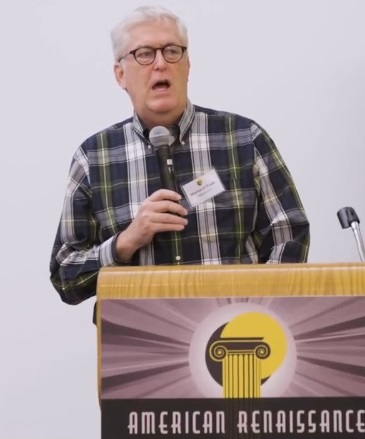
This is the first installment of a two-part series on O’Toole’s racist and antisemitic organizing. As this documentation indicates, O’Toole has been active in the racist movement for over half a century. We are not attempting a comprehensive biography of O’Toole or full overview of his activities. We highlight some aspects of O’Toole’s racist organizing that have received little public attention; have been forgotten over the decades; or have not been exposed until now. As a public figure who tries to sanitize the Confederacy, the full extent of O’Toole’s racist organizing should be known.
In our first installment, we cover O’Toole’s racist agitation at University of Georgia in the 1970s. We then set out evidence that O’Toole helped produce and distribute neo-Nazi newsletters published by NSDAP/AO, a Hitlerite group. We also discuss O’Toole’s help for Instauration, a racist and antisemitic publication. Finally, we set out O’Toole’s efforts in the Holocaust denial milieu, including hosting Atlanta events for Hitler sympathizer David Irving and operating a Holocaust denial book company with Sam Dickson.
Student Activism at University of Georgia
O’Toole’s racist organizing goes back to his college days at the University of Georgia (UGA) in Athens, where he earned his bachelor’s degree in the 1970s. O’Toole later returned to school for his law degree, which he received from Georgia State University’s College of Law in 1989.
At UGA, O’Toole began organizing alongside Sam Dickson, who is a few years his senior. Dickson is a significant white power leader in his own right, who we have discussed extensively on our website. When Dickson’s name crops up in our research, we often find O’Toole’s too.
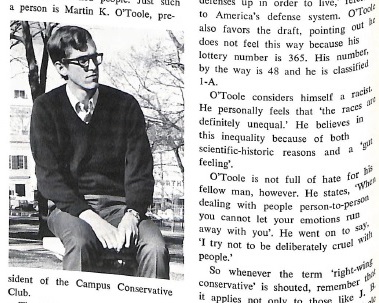
In 1970, Martin O’Toole, Sam Dickson, and others broke away from the rightwing Young Americans for Freedom (YAF), burning the charter for the YAF group at UGA and reforming as the Campus Conservative Club (CCC). [1] Martin O’Toole was president of the new club. [2] According to an interview with Sam Dickson decades later, a key reason for the split from YAF was YAF’s intolerance of “real rightist opinions about race and racial mixing.” [3] CCC had few inhibitions about racism, arguing against the “dogma of [racial] equality” in the pages of its newsletter, Right On! Other themes of Right On! included opposition to gay visibility on campus and thinly veiled antisemitism. [4] A 1972 profile of O’Toole by student publication The Impression stated: “O’Toole considers himself a racist.” [5]
O’Toole, Dickson, and others in the CCC orbit were active in UGA’s Demosthenian Society, a college debate society founded in 1803. The openly racist O’Toole was Demosthenian Society’s President in 1972. [6] Two years later, as part of the Society’s program committee, O’Toole invited William Shockley to speak on campus about his racial beliefs. [7] A Nobel Prize winner for his co-discovery of the transistor, Shockley argued that Black people are innately less intelligent – a claim long debunked by scientists – and championed eugenics as well as government payments in exchange for sterilization. Student groups such as the Black Student Union protested Shockley’s March 5, 1974 speech at UGA. After forty-five minutes of shouting and disruption by students, Shockley departed. [8] (O’Toole’s older friend Sam Dickson graduated UGA with a law degree in 1972, and so had no formal role in the 1974 Shockley event.)
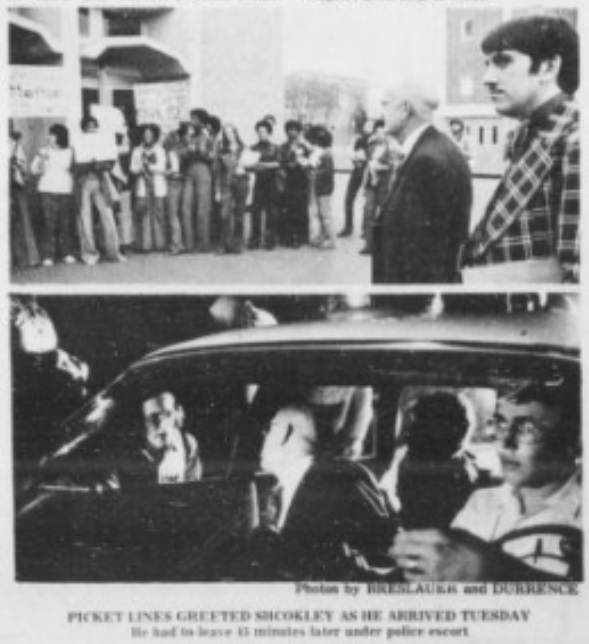
Less than two months after the Shockley event, the Demosthenian Society sponsored a campus speech by klansman, neo-Nazi, and white supremacist candidate Jesse Benjamin (“J.B.”) Stoner on May 2, 1974. [9] Stoner, then running for lieutenant governor in Georgia, ranted to a full house against a “rotten, race mixing system” and “Jew motion picture makers”. [10] Stoner was convicted in 1980 for the 1958 bombing of Bethel Baptist Church in Birmingham, Alabama, whose pastor was a Civil Rights leader.

By Fall 1973, CCC had transformed to a political party, the Union of American People (UAP). [11] The Party claimed to be for “students with conservative to moderate views.” [12] UAP’s newsletter, The People’s Observer, used the same name as a Nazi Party newspaper, the Völkischer Beobachter. O’Toole was an editor. [13]

Like CCC, the UAP promoted biological racism. [14] Its biggest campaign, however, attempted to restore the cultural and symbolic trappings of white supremacy at UGA. In 1972, the CCC complained about the renaming of UGA’s band from the “Dixie Redcoat Band” to just the “Redcoat Band,” as well as the decision by band leader Roger Dancz to remove the song “Dixie” from its repertoire. [15] UAP turned this issue into a sustained pressure campaign on the University and band leader Dancz, which lasted a year and a half. Campaigning on this issue in 1974 student elections, UAP received almost twenty percent of the student vote, leading to a runoff election for the two major student parties. By late 1974, UAP forced the “Dixie” issue to a student referendum, which it won. Dancz nevertheless refused to play the song, which had come to represent white domination. The “Fire Dancz” campaign continued and even escalated until O’Toole’s 1975 graduation, with the UAP circulating a People’s Observer spin-off publication attacking Dancz at the 1975 “G-Day” football game. The campaign ended after its key organizers left college. By April 1976, UAP had “effectively stopped operating as a student political party”. [16]
After Graduation
After graduating University of Georgia with a bachelor’s degree, Martin O’Toole established the Alcovy Publishing Company with business partners in November 1975. Georgia business filings show that Sam Dickson served as the company’s legal representative. We have been unable to find more documentation on O’Toole’s activity with Alcovy Publishing. Coincidentally, the first issue of racist magazine Instauration (see below) surfaced one month after Alcovy Publishing’s formation.

At some point, O’Toole began selling automatic firearms through a company called Selective Fire, Limited. O’Toole maintains a federal firearms license as “Selective Fire” to this day. Advertisements in 1983 and 1984 issues of The American Handgunner offered “1921 Colt Thompsons [a submachine gun and high dollar item] and other fine automatic weapons for sale.” The advertisements provided a Conyers, Georgia, PO Box – this address becomes important as we discuss O’Toole’s work for racist publications.
Work for Racist Publications
(a) New Order and NS Kampfruf
The 1980s saw a spike in Neo-Nazi and white supremacist terror attacks. According to archival records, O’Toole was deeply involved in the publishing of the propaganda that helped animate the movement. In our research on O’Toole, we located documents connecting O’Toole to prepress work, printing payments, and mass mailing for two neo-Nazi newsletters. He obscured his identity behind two company names – “Compulist” and “VIII Publishing” – and facilitated both the production and mailing of Neo-Nazi propaganda.
The propaganda in question was written by a Neo-Nazi based in Nebraska named Gary “Gerhard” Lauck. NS Kampfruf (N.S./National Socialist Battle Cry) and New Order are long-running newsletters by Lauck’s NSDAP/AO organization. The newsletters are published in German and in English, respectively. NSDAP refers to the full name of the Nazi Party. The “AO” of NSDAP/AO is short for “Aufbau- und Auslandsorganisation” or “Development and Foreign Organization.” NSDAP/AO aims to revive the Nazi Party in Germany and Austria; German authorities have unsurprisingly banned the group and its publications. Lauck and his close associates are responsible for importing copious amounts of banned Nazi propaganda into Germany. This eventually led to Lauck’s arrest in Denmark in 1995 and his extradition to Germany, where he served a prison sentence until 1999 and was then deported back to the United States.

According to archives from the Center for Democratic Renewal (CDR), a civil rights and anti-racist monitoring group active from 1979 to 2008, Martin O’Toole had a major role in the production and distribution of New Order and NS Kampfruf in the 1980s.
This distribution arrangement evolved over time. Here is a reconstruction of how the arrangement operated, based on research in the CDR archives:
In the early years, the propaganda chain began with Lauck writing his Neo-Nazi newsletters in Nebraska. He would then send the newsletters to Georgia, where O’Toole handled typesetting under the name “VIII Publishing.” O’Toole, using the “Compulist” company account, then paid for printing at Walton Press of Monroe, Georgia. O’Toole picked up the newsletters from Walton Press. [17] Then, at the post office in Avondale Estates (metro Atlanta), someone named Todd Ingle – linked to O’Toole – dropped off the newsletters to go out to subscribers. Bundles of newsletters may also have been mailed directly from Walton Press to Opal Soltau in Indiana. (Opal Soltau, a Nazi supporter from the times of the German American Bund, was a close associate of Lauck.)
As 1980s printing technology advanced, the chain became simpler. Lauck obtained a laser printer and sent his newsletter directly to Walton Press for printing. Copies then went out from Walton Press to Soltau in Indiana. However even at that point, a portion of the newsletters may have gone to readers from Avondale Estates.

Distributing German language Neo-Nazi newsletters in Germany is a serious crime, for which Lauck was eventually discovered, tried, and convicted. This helps explain the secrecy of the mailing arrangements.
The CDR’s archives include two particularly relevant items:
1. Internal CDR memorandum, June 4, 1986: This memo asserts that Walton Press was paid for printing of New Order with checks on the “Compulist” company account. [18]
2. CDR memorandum on meeting with Georgia Bureau of Investigation (GBI), July 2, 1986: This contains two striking claims by the GBI:
a. VIII Publishing in Conyers, Georgia had previously typeset NS Kampfruf and New Order. VIII Publishing went out of business and Gary Lauck obtained a laser printer to do his own typesetting. Walton Press printed the newsletters and shipped them via surface mail to Opal Soltau at a post office box in Nashville, Indiana.
b. “New Order” was bulk mailed from Avondale Estates, metro Atlanta. Lauck’s NSDAP/AO held a bulk mailing permit at this Avondale Estates post office. The bulk permit was under the name of Opal Soltau, who supplied a Lincoln, Nebraska post office box on the paperwork. Someone named Todd Ingle brought the newsletter mailings to the Avondale Estates post office. Ingle’s phone number matched Martin O’Toole’s. [19]
Regarding the two different post office boxes mentioned in the CDR/GBI memo: the Nashville, Indiana address provided by Opal Soltau was close to this longtime Nazi supporter’s home at the time. The Nebraska box on the Georgia mailing permit is a public contact used by Lauck and NSDAP/AO.
A primary document in the CDR archives confirms that Martin O’Toole was behind “Compulist,” the company that allegedly issued payments to Walton Press for NSDAP/AO print work. We will discuss the relevant document linking O’Toole to Compulist in the next section concerning Instauration.
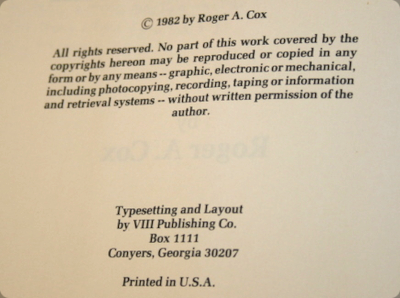
Although CDR archives do not directly tie Martin O’Toole to VIII Publishing, thanks to internet research, we can now reveal that Martin O’Toole also operated VIII Publishing. The copyright page for a rare book, Roger A. Cox’s The Thompson Submachine Gun, published 1982 by Law Enforcement Ordinance Co., credits VIII Publishing of Conyers, Georgia for typesetting. The VIII Publishing address provided on that book’s copyright page is the same post office box used by O’Toole in his American Handgunner advertisements for Selective Fire. Other documents in the CDR archives also link that post office box to O’Toole.
(b) Instauration
Instauration was a racist and antisemitic magazine published from December 1975 to February 2000 by “Wilmot Robertson” (real name Humphrey Ireland) of Cape Canaveral, Florida. Robertson/Ireland is best known for writing The Dispossessed Majority, a book restating the white supremacist worldview. His magazine tried to give racism and Jew-hatred an air of intellectualism, in the same way that projects such as American Renaissance and Charles Martel Society’s The Occidental Quarterly currently attempt.

In the second issue of Instauration (January 1976), an anonymous submission stated that “Instauration has close ties with the Union of the American People (UAP), an organization of Majority [i.e., white] students at the University of Georgia.” The piece begins with UAP’s gripes against “Dixie” being cut from the UGA band repertoire; moves to attacking a visiting professor of journalism who had criticized the UAP “Dixie” campaign, insinuating along the way that a Jewish conspiracy controls the media; and climaxes in a segregationist rant. [20] The article clearly came from O’Toole’s political circles, possibly O’Toole himself.
For at least part of Instauration’s existence, Martin O’Toole managed its bulk mailing. According to January 1, 1987 postal service paperwork in the CDR archives, “Compulist” held the mailing permit used for sending Howard Allen Enterprises materials. Howard Allen Enterprises was the company that published Instauration. The publications went out to subscribers from Conyers, Georgia. Martin O’Toole signed as the holder of the “Compulist” mailing permit. The post office box O’Toole provided for “Compulist” matches the one used by his Selective Fire, Limited and VIII Publishing companies. [21]
Holocaust Denial, David Irving, and Historical Review Press – USA
In February 1986, Martin O’Toole traveled with Sam Dickson to the Institute for Historical Review’s conference in California, a major gathering for Holocaust deniers. Dickson was one of the scheduled speakers, while O’Toole distributed and promoted Instauration at the gathering. [22]

According to a 1986 article in The Southern Israelite newspaper, O’Toole and Dickson ran the Atlanta Committee for Historical Review (ACHR). [23] ACHR hosted two speaking events for British Holocaust denier David Irving in 1986. According to Center for Democratic Renewal archives, both appearances were held at the Waverly Hotel near Smyrna. For Irving’s April 7 speech, O’Toole’s number was provided as the event information line. [24] For Irving’s second appearance on October 15, O’Toole’s number appeared on the ACHR promotional letter. [25] At this second event, Dickson, O’Toole, and veteran white supremacist Ed Fields provided introductory remarks before Irving’s speech. Although Irving discussed his usual “revisionist” topics, most of his speech defended apartheid in South Africa. [26]
Irving has appeared in Atlanta several times since these 1986 speaking events. For example, according to the October 1987 issue of Instauration, Irving planned to speak in Atlanta on October 24. [27] Dickson and O’Toole almost certainly helped organize this 1987 gathering, as well as many of Irving’s subsequent visits.
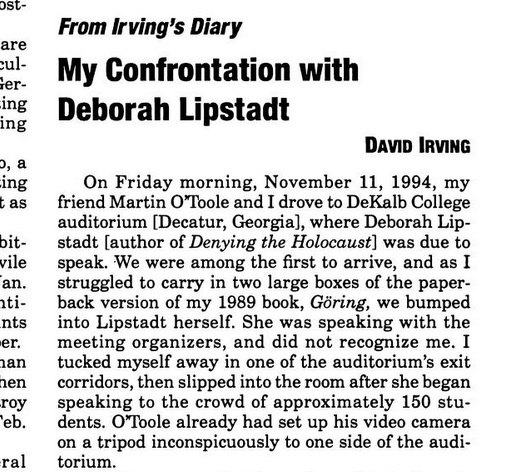
On November 11, 1994, Martin O’Toole – by then a lawyer – accompanied David Irving to a presentation at DeKalb College (Decatur, Georgia) by scholar Deborah Lipstadt. At this event, Irving confronted Lipstadt for accurately describing him as a Holocaust-denier, while O’Toole recorded video. Irving referred to O’Toole as “my friend” in his account of this incident, published in the Holocaust denial Journal of Historical Review. [28] Irving would later sue Lipstadt and her publisher Penguin Books for libel in English courts. Irving lost his case, with the 2000 ruling against Irving stating: “Irving […] is an active Holocaust denier; […] he is anti-Semitic and racist, and […] he associates with right-wing extremists who promote neo-Nazism.”
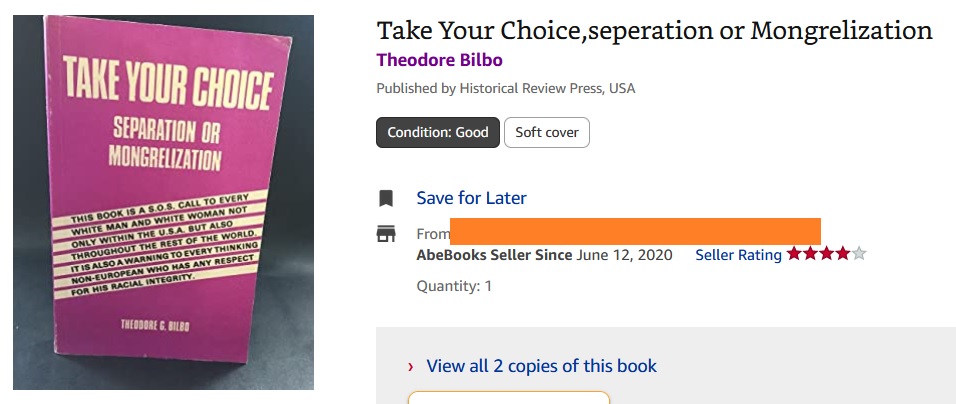
In 1989, Sam Dickson and O’Toole incorporated Historical Review Press – USA in Georgia. The business had already operated for at least two years prior to this formal incorporation: a 1987 issue of Instauration mentioned the company as a US source for one of David Irving’s books when promoting Irving’s upcoming speeches. The name of Dickson and O’Toole’s book company parallels the name of a UK operation called Historical Review Press. The UK company specialized in Holocaust denial materials; its owner did printing for and worked closely with Irving. Dickson and O’Toole’s “Historical Review Press – USA” primarily operated as a mail order company, promoting and distributing works by authors such as Irving, UK fascist John Tyndall, and neo-Confederate/white nationalist Michael Andrew Grissom. [29] The company also distributed Theodore Bilbo’s Take Your Choice: Separation or Mongrelization and other dusty racist volumes. After the company failed to provide annual paperwork, the State of Georgia administratively dissolved Historical Review Press – USA in 1992.
Summary/Conclusion (Part One)
We have documented three aspects of Martin O’Toole’s racist organizing from the 1970s to the early-/mid-1990s. First, we discussed O’Toole’s agitation while a student at University of Georgia. Martin O’Toole was centrally involved in two student groups that promoted biological racism: the Campus Conservative Club, then later the Union of American People.
While O’Toole was on Demosthenian Society’s program committee in 1974, the group hosted eugenicist and anti-Black racist William Shockley. Less than two months later, this Society sponsored an appearance by klansman and neo-Nazi JB Stoner, who was later convicted for a 1958 bombing against a church in Alabama.
We highlighted archival documents which tie O’Toole to the typesetting and mass mailing of neo-Nazi newsletters during the 1980s. An O’Toole company, Compulist, also cut checks for the printing of the NSDAP/AO newsletters, according to the Center for Democratic Renewal’s archives. “Compulist” and O’Toole were also responsible for mass mailing issues of Instauration, a racist and antisemitic journal, to its subscribers. Finally, we discussed O’Toole’s role in the Holocaust denial scene, such as organizing metro Atlanta appearances for David Irving. Working alongside Sam Dickson, O’Toole operated a white nationalist/Holocaust denial book company. This project lasted from at least 1987 until the early 1990s.
While the Sons of Confederate Veterans claim to be about “heritage, not hate,” Martin O’Toole uses themes of “heritage” and Southern identity while pursuing an ideologically white supremacist agenda. By making the President of the white nationalist Charles Martel Society their Georgia spokesman, the Sons of Confederate Veterans highlights the racism at the core of their organization.
Martin O’Toole’s wealth and class position have to a large degree insulated him from the consequences of his half century of white supremacist organizing. Perhaps because he does not fit the typical media template of a neo-Nazi or klansman, mainstream journalists have not given his activities the attention they clearly deserve. There is much to discuss in his long racist history, and we have only covered half of it in this article. We hope to publish the second half of our Martin O’Toole documentation by the end of May. Until then, if you have further information on O’Toole or his close associates, please get in touch.
Notes
[1] Christopher A. Huff, “Conservative Student Activism at the University of Georgia,” in Rebellion in Black and White: Southern Student Activism in the 1960s, ed. Robert Cohen and David J. Snyder (Baltimore: John Hopkins University Press, 2013), 171-188, 176.
[2] Ibid., 179.
[3] Christopher A. Huff, “Radicals Between the Hedges: New Left Activism at the University of Georgia, 1963 – 1975” (MA thesis, University of Georgia, 2005), 109.
[4] Huff, “Conservative Student Activism,” 176-177 & 178.
[5] Ken Soseby, “Martin O’Toole,” The Impression Vol. 6, No. 2 (Winter 1972), 8.
[6] University of Georgia, Pandora yearbook (Athens, GA: 1972), 240.
[7] Deborah Blum, “Shockley Brings Dispute to UGA,” The Red and Black, March 1, 1974, 1.
[8] Deborah Blum, “Students Force End to Shockley Speech,” The Red and Black, March 6, 1974, 1.
[9] “Bulletin Board,” The Red and Black, May 2, 1974, 2.
[10] Eddie McLaurin, “Stoner Running as Open Racist,” The Red and Black, May 7, 1974, 5.
[11] Huff, “Conservative Student Activism,” 180.
[12] “UAP Holds First Meeting of Quarter,” The Red and Black, October 5, 1973, 1.
[13] “Rag” (editorial), The Red and Black, April 29, 1975, 4.
[14] Huff, “Conservative Student Activism,” 183.
[15] Ibid., 179-180.
[16] Ibid., 184-186.
[17] Center for Democratic Renewal, “Sam Dickson Investigation” memo, 1986, Center for Democratic Renewal Records, Archives Division, Auburn Avenue Research Library on African American Culture and History, Atlanta-Fulton Public Library System. Handwritten note “now verified” next to claim that O’Toole picked up newsletters from Walton Press.
[18] Memorandum re: Dickson investigation, June 4, 1986, Center for Democratic Renewal Records.
[19] Memorandum on meeting with Georgia Bureau of Investigation, July 2, 1986, Center for Democratic Renewal Records.
[20] “Stirrings,” Instauration Vol. 1, No. 2 (January 1976), 23.
[21] “Statement of Mailing with Permit Imprints” for permit no. 22 at Conyers, Georgia post office (dated January 1, 1987), Center for Democratic Renewal Records.
[22] Leonard Zeskind, Blood and Politics: The History of the White Nationalist Movement from the Margins to the Mainstream (New York: Farrar, Straus and Giroux, 2009), 119.
[23] Michael Winograd, “Elie Wiesel Ridiculed,” The Southern Israelite, October 24, 1986, 5.
[24] Monitoring report for April 7, 1986 David Irving speech, Center for Democratic Renewal Records.
[25] Atlanta Committee for Historical Review, “David Irving Returns to Atlanta” promotional sheet, 1986, Center for Democratic Renewal Records.
[26] Monitor’s report for October 15, 1986 David Irving speech, Center for Democratic Renewal Records.
[27] “Two Great Meetings, One Great Book,” Instauration Vol. 12, No. 11 (October 1987), 35-36.
[28] David Irving, “From Irving’s Diary: My Confrontation with Deborah Lipstadt,” The Journal of Historical Review Vol. 15, No. 1 (January/February 1995), 28-30, 28.
[29] Historical Review Press – USA, undated promotional sheets for The Last Rebel Yell by Michael Andrew Grissom, Hitler’s War by David Irving, and The Eleventh Hour by John Tyndall, Center for Democratic Renewal Records.